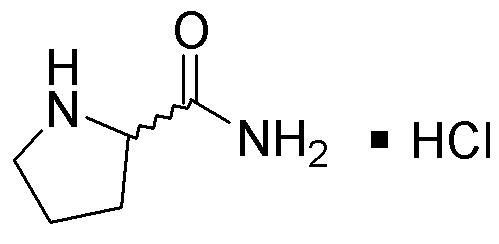DL-Proline amide hydrochloride is widely utilized in research focused on:
- Pharmaceutical Development: This compound serves as a building block in the synthesis of various pharmaceuticals, particularly in the development of drugs targeting neurological disorders.
- Peptide Synthesis: It is commonly used in the synthesis of peptides, which are crucial for developing new therapeutic agents and understanding biological processes.
- Protein Engineering: Researchers leverage its properties to modify proteins, enhancing their stability and functionality, which is vital in biotechnology applications.
- Food Industry: It acts as a flavor enhancer and is used in food formulations, providing a unique taste profile while being safe for consumption.
- Research in Metabolism: The compound is utilized in studies examining metabolic pathways, helping scientists understand amino acid metabolism and its implications for health.
General Information
Properties
Safety and Regulations
Applications
DL-Proline amide hydrochloride is widely utilized in research focused on:
- Pharmaceutical Development: This compound serves as a building block in the synthesis of various pharmaceuticals, particularly in the development of drugs targeting neurological disorders.
- Peptide Synthesis: It is commonly used in the synthesis of peptides, which are crucial for developing new therapeutic agents and understanding biological processes.
- Protein Engineering: Researchers leverage its properties to modify proteins, enhancing their stability and functionality, which is vital in biotechnology applications.
- Food Industry: It acts as a flavor enhancer and is used in food formulations, providing a unique taste profile while being safe for consumption.
- Research in Metabolism: The compound is utilized in studies examining metabolic pathways, helping scientists understand amino acid metabolism and its implications for health.
Documents
Safety Data Sheets (SDS)
The SDS provides comprehensive safety information on handling, storage, and disposal of the product.
Product Specification (PS)
The PS provides a comprehensive breakdown of the product’s properties, including chemical composition, physical state, purity, and storage requirements. It also details acceptable quality ranges and the product's intended applications.
Certificates of Analysis (COA)
Search for Certificates of Analysis (COA) by entering the products Lot Number. Lot and Batch Numbers can be found on a product’s label following the words ‘Lot’ or ‘Batch’.
*Catalog Number
*Lot Number
Certificates Of Origin (COO)
This COO confirms the country where the product was manufactured, and also details the materials and components used in it and whether it is derived from natural, synthetic, or other specific sources. This certificate may be required for customs, trade, and regulatory compliance.
*Catalog Number
*Lot Number
Safety Data Sheets (SDS)
The SDS provides comprehensive safety information on handling, storage, and disposal of the product.
DownloadProduct Specification (PS)
The PS provides a comprehensive breakdown of the product’s properties, including chemical composition, physical state, purity, and storage requirements. It also details acceptable quality ranges and the product's intended applications.
DownloadCertificates of Analysis (COA)
Search for Certificates of Analysis (COA) by entering the products Lot Number. Lot and Batch Numbers can be found on a product’s label following the words ‘Lot’ or ‘Batch’.
*Catalog Number
*Lot Number
Certificates Of Origin (COO)
This COO confirms the country where the product was manufactured, and also details the materials and components used in it and whether it is derived from natural, synthetic, or other specific sources. This certificate may be required for customs, trade, and regulatory compliance.


